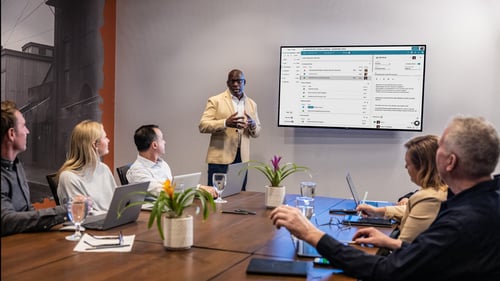Too Many Meetings? Here's How Leaders Can Boost Productivity
The right meetings are always worth it. But leaders and managers are attending so many of them, it’s taking up a substantial amount of their time and energy. We’ll provide some strategies for decreasing the reactive, limited-scope meetings that jam up our day, while enhancing the meetings we truly need to help boost overall productivity and job satisfaction.
___
On any given Monday morning, you can ask an organizational leader or manager what their week looks like, and the response is bound to go something like, “Well, I have a ton of meetings, I can tell you that much. Here, look at this calendar!”
Surely, many of those meetings are vital to sharing or gathering information that keeps everything humming, from current project work to the long-range plans that are critical to sustained growth and success. But, without exception, every manager or leader feels a degree of strain from the sum total of these meetings and the obligation to be present for every last one of them.
We’re here to share some encouraging news: it doesn’t have to be this way. You CAN get some time back on your calendar. It all comes down to ensuring you’re attending the right meetings (defining the purpose of those meetings is key), and punting on the ones you don’t really need in the first place.
Because as leaders, it’s especially important for us to have enough time to work on the business, rather than always working in the business.
The Impact of Spending Time on the Wrong Meetings
It’s one thing to say leaders are attending too many meetings, but it’s another thing altogether to show it. So here are a few statistics to illustrate the point:- Top-level executives have as many as 17 meetings per week.
- Only 17% of senior managers consider their meetings productive.
- 24 billion hours (!) are wasted each year as the result of unproductive meetings.
Think about the potential for burnout if you’re in all these meetings and only a fraction of them are effective or productive. Then consider the impact on your team members, who also attend too many inefficient meetings: motivation, morale, creativity, and productivity are bound to go down. Even if only one or two of those attributes declined across a subset of teams, you’d discover there’s a big hit to how people view the organizational culture.
These days, the sheer amount of teleconferencing solutions makes it almost too easy to have an impromptu huddle or book an ad hoc meeting. Both are, by their very nature, unexpected and disorganized. That, coupled with the often-automatic action many have of accepting every single meeting invite (what many might call fear of missing out, or FOMO), makes for a clogged calendar and a chaotic day.
So, what can we do about it? A few suggestions:
- Avoid ad hoc meetings by asking, “If it's not urgent and important, can it wait for our Weekly Team Meeting or our weekly 1-on-1?” Ad hoc meetings kill productivity for a host of reasons, the two biggest being they interrupt your concentration and (even worse) often have neither an agenda nor the right attendees to properly solve Issues.
- Think about the meetings you find wasteful and consider suspending them, especially if they fall into the category above. Challenging a meeting’s purpose makes for a healthy discussion when you notice it’s having a negative effect on team members. Do this exercise every now and again.
- Look at the meeting duration for those already on the calendar. Does a weekly brainstorming session really have to be 2.5 hours? Does it really need 14 people in it? The answers may (and probably should) be “No” and “No.”
- Decline ad hoc meetings you simply cannot attend, offering to provide any necessary status updates via email, Slack, or some other means. Encourage others to do the same. This helps: our Meetings tool offers recaps so you never miss a highlight.
- Don’t succumb to the pressure of having or attending meetings simply to validate the appearance of being productive or in control. A strong culture built on trust and agreements makes that entirely unnecessary. Instead, ask, “If it’s not recurring or necessary, why is this meeting even taking place?"
- Set an appropriate cadence for the right meetings. Weekly 1-on-1 meetings and weekly team updates are important… but maybe the 1-on-1 can be every other week. Discuss meeting cadence with team members to ensure it’s always time well spent.
- Don’t “throw time on the calendar in case we need it.” Others who are trying to book purposeful meetings need to schedule around these “maybe meetings,” leading to clogged calendars and increased stress.
Communication Is Key for the Meetings We Need
Many companies have implemented remote or hybrid working arrangements for their team members, and they’ve found great success in such models. We’d argue that the best of them have implemented some agreed-upon norms for ensuring maximum effectiveness when balancing team members’ needs with the need for certain meetings.
As leaders, we should think about the makeup of our teams and implore other leaders in the organization to do the same. Where are people located? What function do they perform, and when do they perform it best? If we simply schedule meetings at a “time that most people had open,” we might be blocking people from doing their best work at the time that works best for them or disrupting the continuity they need when they’re heads down in the work.
Talking to teams and setting agreements goes a long way to meeting mindfully. True, it’s near impossible to set agreements that work 100% of the time for 100% of your team members. But conversation is key. When you know — and appreciate — the different working styles of others, you begin to think more about how and when to schedule required meetings.
There’s also the idea of instituting a block of time during the day with no meetings at all. Or maybe a whole day. Or (let’s get wild) maybe two days without meetings! Allowing big chunks of meeting-free time to let your teams focus on their most critical tasks is an easy win. We’ve implemented that tactic here at Ninety, and it’s been wildly successful for our fully remote team members.
Strategies for Managing Meetings More Effectively
Let’s now turn the focus to making the most of the meetings we keep to ensure we’re working at peak productivity. Assuming we’ve established the purpose and have the right (read: necessary) attendees, the key to meeting effectiveness comes down to having a rock-solid agenda.
That sounds obvious, but it might surprise you to know that only 37% of workplace meetings actively make use of meeting agendas.
At Ninety, our meetings use a time-tested agenda, and our Meetings tool also features an in-app timer so you can see how you’re tracking to that agenda as the meeting progresses. Staying on track and ending on time are essential for a great meeting.
Another key to having a great meeting is to prioritize your Issues. At Ninety, we prioritize our Issues this way:
- 5 = Must Raise, Discuss, and Resolve (RDR) the Issue today and want to discuss as early as possible
- 4 = Must RDR today
- 3 = Should RDR today if we have time
- 2 = Don’t need to RDR today, but should resolve it soon
- 1 = Not urgent, but it would be good to resolve it someday
After resolving all 5s and 4s, if we have time, we address 3s that make sense based on the time remaining. For us, it’s often more useful to end the meeting earlier than to spend extra time working on 2s and 1s. It’s better that everyone walks out of the meeting knowing we did the work that absolutely had to be done.
Finally, one of the other things we do at Ninety is a discipline we call Who, With, One, What, and Why. This approach helps the Issue owner and team members deconstruct an Issue and verbally process it in real-time. Several of our senior leaders are also coaches, and this discipline has been a huge stress saver for every one of their clients because it minimizes tangents and rabbit holes. Here’s the discipline in a nutshell:
- Who — Who are we solving for? Usually, it’s for the Issue’s owner.
- With — With whom do you have this Issue? This may be an individual team member or a whole team, represented by the team leader.
- One — Summarize the Issue in one sentence. The one-sentence limitation, though challenging, simplifies the Issue, making it easier to solve.
- What — What does the Issue’s owner need to resolve it? They may need information, assistance, confirmation, or something else entirely.
- Why — Why are we talking about this Issue in this forum? This highlights why the Issue needs to be discussed with the entire team.
Regardless of the method used, the team should have the opportunity to ask the Issue owner follow-up questions. The Facilitator manages this process to ensure that everyone present has complete clarity on the Issue that needs to be resolved and the associated context.
Each of these disciplines can be easily mastered if you have someone assigned to keep an eye on the time and you're able to make sure people play by your rules. Moving things along leads to better, more focused conversations. And that certainly leads to better meeting outcomes… for those meetings we really, truly need.
Streamline Your Meetings and Boost Productivity for Free
Want to transform your team's meeting practices and drive better results? Introducing Meetings, one of the tools in Ninety’s software platform that automates meetings, streamlines collaboration, and maximizes productivity. Try it today and see the difference for yourself!






